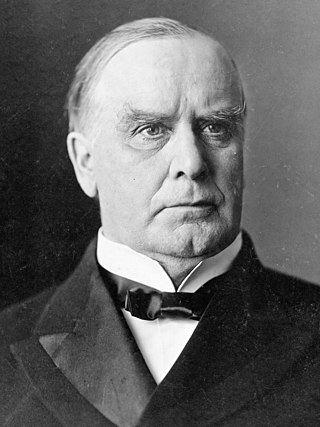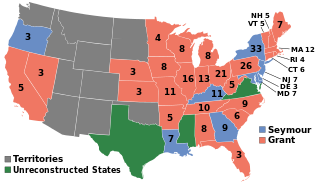Related Research Articles

The vice president of the United States (VPOTUS) is the second-highest officer in the executive branch of the U.S. federal government, after the president of the United States, and ranks first in the presidential line of succession. The vice president is also an officer in the legislative branch, as the president of the Senate. In this capacity, the vice president is empowered to preside over the United States Senate, but may not vote except to cast a tie-breaking vote. The vice president is indirectly elected together with the president to a four-year term of office by the people of the United States through the Electoral College. Since the passage of the Twenty-fifth Amendment to the US Constitution, the vice president may also be appointed by the president to fill a vacancy, via majority confirmation by both the Senate and the House.

The 1796 United States presidential election was the third quadrennial presidential election of the United States. It was held from Friday, November 4 to Wednesday, December 7, 1796. It was the first contested American presidential election, the first presidential election in which political parties played a dominant role, and the only presidential election in which a president and vice president were elected from opposing tickets. Incumbent vice president John Adams of the Federalist Party defeated former secretary of state Thomas Jefferson of the Democratic-Republican Party.

The 1884 United States presidential election was the 25th quadrennial presidential election, held on Tuesday, November 4, 1884. In the election, Governor Grover Cleveland of New York defeated Republican James G. Blaine of Maine. It was set apart by unpleasant mudslinging and shameful personal allegations that eclipsed substantive issues, such as civil administration change. Cleveland was the first Democrat elected president of the United States since James Buchanan in 1856, the first to hold office since Andrew Johnson left the White House in 1869, and the last to hold office until Woodrow Wilson, who began his first term in 1913. For this reason, 1884 is a significant election in U.S. political history, marking an interruption in the era when Republicans largely controlled the presidency between Reconstruction and the Great Depression.

The 1900 United States presidential election was the 29th quadrennial presidential election, held on Tuesday, November 6, 1900. In a re-match of the 1896 race, incumbent Republican President William McKinley defeated his Democratic challenger, William Jennings Bryan. McKinley's victory made him the first president to win a consecutive re-election since Ulysses S. Grant accomplished the same feat in 1872. Until 1956, this would be the last time in which an incumbent Republican president would win re-election after serving a full term in office. This election saw the fifth rematch in presidential history but the first to produce the same winner both times; neither would occur again until 1956.
Veep is an American political satire comedy television series that aired on HBO from April 22, 2012, to May 12, 2019. The series was created by Armando Iannucci. The protagonist of Veep is Selina Meyer, a fictional Vice President of the United States. The series follows Meyer and her team as they attempt to make their mark and leave a legacy but often instead become mired in day-to-day political games.

David Davis was an American politician and jurist who was a U.S. senator from Illinois and associate justice of the United States Supreme Court. He also served as Abraham Lincoln's campaign manager at the 1860 Republican National Convention, engineering Lincoln's successful nomination for president by that party.

The 1968 United States elections were held on November 5, and elected members of the 91st United States Congress. The election took place during the Vietnam War, in the same year as the Tet Offensive, the assassination of Martin Luther King, Jr., the assassination of Robert F. Kennedy, and the protests of 1968. The Republican Party won control of the presidency, and picked up seats in the House and Senate, although the Democratic Party retained control of Congress.

Selina Catherine Meyer is a fictional character portrayed by Julia Louis-Dreyfus on the HBO television comedy series Veep. Louis-Dreyfus has been critically acclaimed for the role, earning a record-breaking six consecutive Primetime Emmy Award for Outstanding Lead Actress in a Comedy Series awards and five Golden Globe Award for Best Actress – Television Series Musical or Comedy nominations.

The 1868 United States elections was held on November 3, electing the members of the 41st United States Congress. The election took place during the Reconstruction Era, and many Southerners were barred from voting. However, Congress's various Reconstruction Acts required southern states to allow Black men to vote, and their voting power was significant to the elections results.
References
- ↑ Caidin, Martin (1967). No Man's World. E. P. Dutton & Co. LCCN 67-10065.
- ↑ Published by Standard Books, Chicago, 1955, reprinted 1961 and 1973